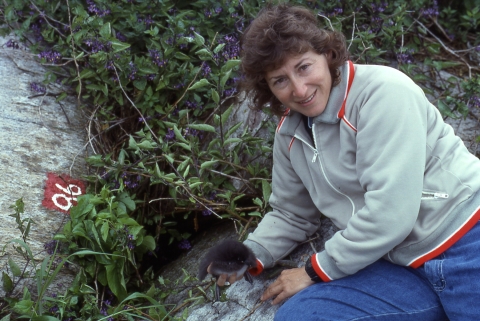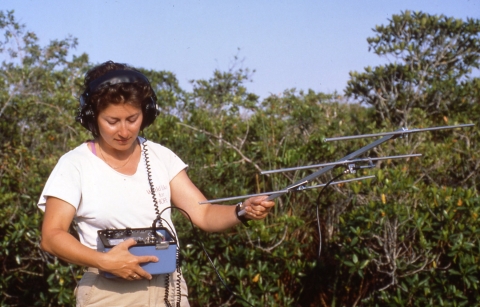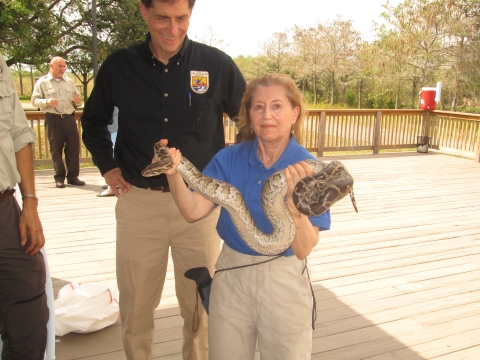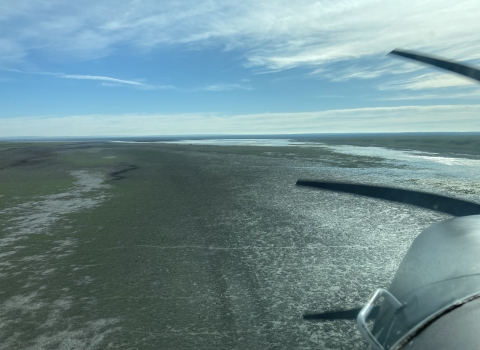Susan Jewell is a wildlife biologist and environmental writer who has studied wildlife up and down the East Coast by motorboat, airboat, canoe, airplane, helicopter, scuba, and muddy feet.
She grew up on the Jersey Shore and has worked for the National Park Service, National Audubon Society, and the U.S. Fish and Wildlife Service, where she has worked since 1992. After an encounter with American folk singer and conservationist Pete Seeger and the establishment of the first Earth Day, Susan was convinced that the best use of her energy was to support conservation.
The beauty of the mountains led Susan to the University of Vermont, where she earned a bachelor’s in wildlife biology. From there, she went to the University of Connecticut and earned a master’s in systematics and evolutionary biology. The Connecticut Department of Environment Protection granted her funding to determine the amount of habitat in the state that could sustain a bobcat population. She explains, “That project was the first bobcat population study ever done in Connecticut, despite bobcats never being extirpated there.” She was excited to learn that her research held its value after 35 years when a Connecticut state biologist showed how he was comparing his new data with Susan’s, as Susan’s was the only baseline data available.
When wood storks were listed as federally endangered, Susan moved to Georgia to study their northernmost colony for the Savannah River Ecology Lab. She continued working on wading birds with the National Audubon Society in the Florida Keys, which were affected by the human-induced hydrological changes in the Everglades. Susan learned to design and build radio transmitters from scratch, then she fitted them to tricolored and little blue herons. She tracked their movements by airplane and was airborne so often that she learned to fly and got her pilot’s license. Susan tracked a single tricolored heron for four years as it adapted to the changing water conditions by nesting at five colonies. That one bird taught her so much about herons, she featured it in her chapter on wading birds in The Book of the Everglades, a collection of natural history stories by invited Everglades authors, including Carl Hiaasen and Susan Orlean. Her other research projects include measuring nesting success of alligators in Everglades National Park and using telemetry to find Atlantic puffin pelagic feeding waters for the National Audubon Society.
As the senior biologist at Arthur R. Marshall Loxahatchee National Wildlife Refuge in the northern Everglades, Susan was heavily involved in Everglades restoration, which was “extremely complex, time-consuming, but much needed.” Through the years, she realized that in addition to researching the survival needs of wildlife, she is also passionate about writing on environmental issues for the general public. In her free time, she wrote about the Everglades and Florida Keys in her first book, Exploring Wild South Florida, followed by the second, Exploring Wild Central Florida. After transferring to the Service Headquarters in northern Virginia, she published her third book, Gators, Gourdheads, and Pufflings—a biologist slogs, climbs, and wings her way to save wildlife. She has published dozens of newspaper and magazine articles on environmental issues, and chapters in books, such as Everglades—The Ecosystem and Its Restoration, Great Florida Birding Trail, and Bioregional Assessments—Science at the Crossroads of Management and Policy. On the job, Susan has contributed numerous articles to Department of the Interior and Service publications.
She worked in the Endangered Species Program in Headquarters for 11 years, beginning with outreach positions, such as the associate editor of the Endangered Species Bulletin and reviewing editor for Birdscapes. Susan was an instructor for the National Conservation Training Center’s Critical Writing and Critical Thinking course for 5 years, where she found gratification teaching our employees how to write more effectively.
She was designated to be the Service’s representative on three international governmental bodies for shared at-risk species. Susan says, “As the only representative on all three North American groups, I realized the great opportunity for the three groups to coordinate conservation of the grasslands—the ecosystem of greatest geographic scope spanning the three countries and the most threatened. I brought this to the attention of the three groups, which then started coordinating their conservation efforts across the borders.”
When she switched to Endangered Species listing, Susan says she realized, “Listing species as threatened or endangered was such a critical job. But then I took a temporary assignment in Injurious Wildlife Listing and found it to be such a powerful authority that the Service has from Congress and so underappreciated that I asked to stay permanently.” Thus, for the past 12 years, she’s served as Injurious Wildlife Listing Coordinator for the Service, and it has been her mission to get attention for injurious listing. This work includes preventing the introduction of harmful species as the only way to fully avoid impacts of injurious species on local, regional, and national economies and infrastructure, and on the natural resources of the United States. History has shown that preventing the importation of high-risk invasive species invasive species
An invasive species is any plant or animal that has spread or been introduced into a new area where they are, or could, cause harm to the environment, economy, or human, animal, or plant health. Their unwelcome presence can destroy ecosystems and cost millions of dollars.
Learn more about invasive species into the United States before they become established is an efficient and effective way to prevent species invasions that would ultimately burden the American people. She has taken it upon herself to evaluate the effectiveness of this program. Her study, along with Pam Fuller from USGS, revealed that, of the species listed as injurious for their traits of invasiveness, if they are listed (prohibited from importation) before they are established, they have a 100% chance of not establishing as an invasive species. She also published a companion paper that is the only written history of injurious listing from 1900 to the present.
Most recently, Susan is proud of coordinating the regulation that lists Burmese and reticulated pythons and six other giant, foreign constrictor snakes as injurious. She’s also proud of the long process that ended with the rule to protect our native salamanders from a lethal salamander chytrid fungus that is not yet found in the United States. In 2021, she received the “Alison Haskell Award for Excellence in Herpetofaunal Conservation” from the Partners in Amphibian and Reptile Conservation, largely for her role in coordinating the rule to list salamanders as injurious, thus prohibiting their importation because of the risk they can carry the fungus into the United States. Check out her recent article titled, "Minimizing the Spread of Herpetofaunal Pathogens in Aquatic Habitats by Decontaminating Construction Equipment."
Susan has wit, and warmth, and has spent her life committed to conservation. Check out her recent articles published in the journal of Management of Biological Invasions, A decision support system for identifying potentially invasive and injurious freshwater fishes, as well as Comparing Invasive Species Risk Screening Tools FISRAM, ERSS, and FISK/AS-ISK. The FWS Scholar blog series celebrates scientists in the Service who are publishing peer-reviewed scientific literature and is brought to you by the USFWS Library, #WeAreUSFWS, #SomosUSFWS.







